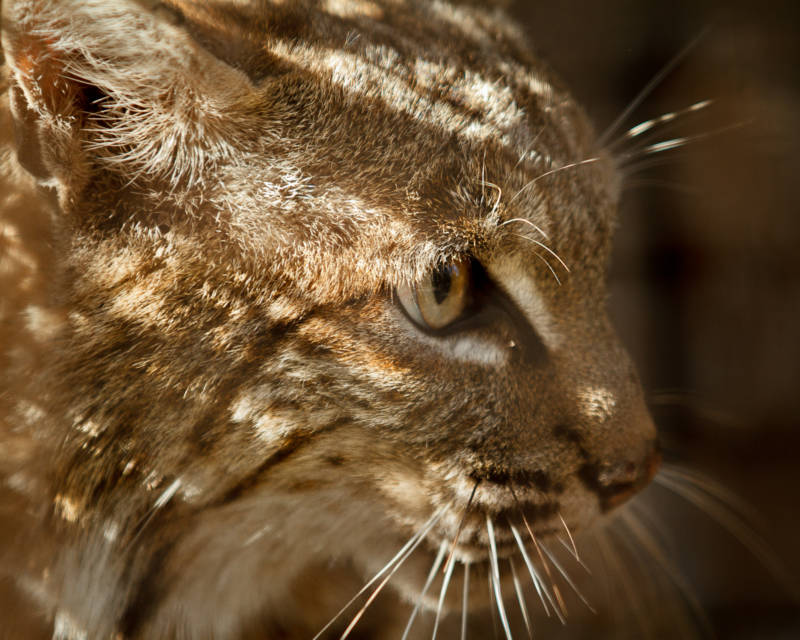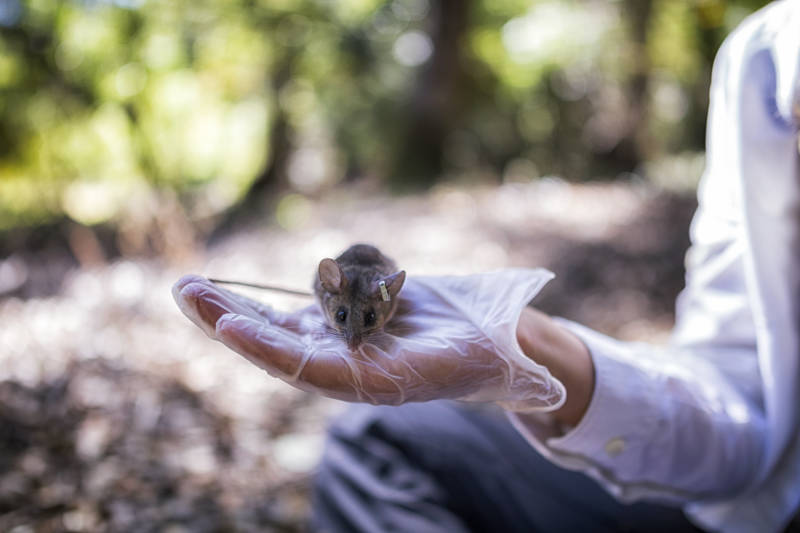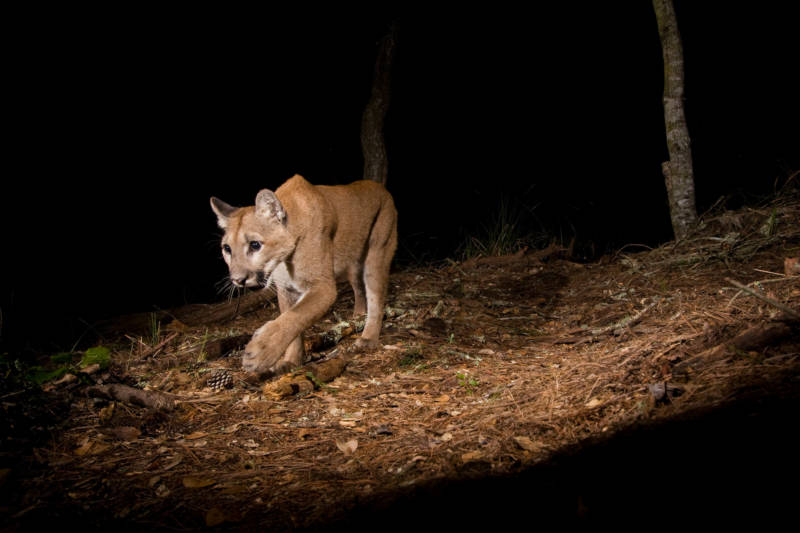In the mountains near Santa Cruz, there’s an area where nature’s rules don’t seem to apply. Everything looks normal — there’s a stream, oak trees, redwoods, bobcats, skunks and the occasional opossum. Pacific tree frogs croak all day and into the night.
Only those who listen carefully would notice that something in this remote spot sounds unusual. Human voices have joined the mix — and they’re reading, sometimes a short story written by Paul Bowles, at other times, poetry by Gwendolyn Brooks.
These voices, and only these, have dramatically affected the way life moves through the area. Mountain lions avoid their old paths, and bobcats emerge almost exclusively at night. Rodents, meanwhile, have gotten bolder.
The creatures are responding to virtual voices — recordings that UC Santa Cruz researchers are playing through loudspeakers they’ve placed in the forest.
Scientists have used these sounds to study, for the first time, how entire ecosystems react to the fear of humans in their midst. These studies begin to quantify a painful truth: that humans alter any landscape in which we live, often in ways we can’t anticipate.
Phantom Voices
UC Santa Cruz wildlife ecologist Justin Suraci says it’s hard for humans to fully understand how fear plays out in wild animals. Humans can’t really say that an animal feels fearful emotions, so Suraci and other researchers chose to monitor fear by observing how animal behavior changes when predators may be near.

Suraci and his research adviser, Chris Wilmers, wanted to find out whether just the fear of humans — without a road or other physical markers nearby — would be enough to change animals’ behavior. To test their hypothesis, they chose the easiest sense to control: sound.
The researchers staked out two separate square kilometers in the Santa Cruz Mountains. For five weeks, the team broadcast recordings of their voices, meant to mimic what animals might hear in a wildlife-urban interface, from 25 speakers in each region. The voices spoke infrequently, but creatures could hear them occasionally from any point in the area.
By simultaneously studying the behavior of mountain lions, smaller carnivores such as bobcats, and prey such as deer mice, the team was able to isolate the effects of fear rippling through an ecosystem. Each species responded a little differently. Mountain lions avoided the area and moved more cautiously when they heard the voices, and bobcats started hunting mostly at night. Skunks moved around less than before; opossums took, on average, almost two days longer than usual to find food. Deer mice, by contrast, reveled in the absence of the large carnivores. They became bolder and foraged for food more thoroughly and in larger areas than they’d covered before.
Previous experiments have suggested the influence of sound on a single species. Songbirds avoided a “phantom road” in Idaho, where researchers played the sounds of passing cars. Mule deer in Colorado differentiated between predators based on their calls.
But these experiments become much more complicated when they consider how fear moves through an entire landscape. The reintroduction of wolves to Yellowstone has sparked a debate about whether the fear of wolves or their actual killing behavior changed elk habits enough to produce a cascade of effects that ultimately changed the shape of rivers.

Suraci says it’s a challenge to prove just why these changes happen, because it can be nearly impossible to divorce the fear of a predator from the predator’s actions. “So this has ended up being one of the first large landscape-scale experiments,” he says, “demonstrating this ‘landscape of fear’ — that just the fear of a predator can affect species,” even across an entire food web.
An Ancient Principle
Bold critters might not seem extraordinary to people who live in cities, or who’ve watched the popular video of “Pizza Rat” brazenly dragging an entire slice of pizza down the stairs of a subway station. But researchers say they’re impressed that Suraci and Wilmers have been able to link rodents’ behavior in a wild habitat to the rest of the ecosystem.
Jon Young, author of “What the Robin Knows,” leads classes on bird language and animal tracking. He says it hadn’t occurred to him that sound, not a predator’s scent or physical presence, would set off fear in an ecosystem. But, he adds, he’s familiar with the idea that fear trickles down through a food web. Finding a predator by observing the behavior of its prey is an ancient tracking principle.
Young recalls how he once tried to photograph a mountain lion, but couldn’t find any footprints. What he did find was that deer clustered near a house with a dog, an animal that usually made them uncomfortable.
“The fact that the deer were up close to the house on a consistent basis told us that they were using human presence as a safety barrier,” Young remembers. “So then we said, ‘Well, what are the deer afraid of?’” Sure enough, when he and his colleagues set up cameras near where deer were avoiding their favorite foods, within a few days the team had their mountain lion photos.
Striking a Balance
Young pays particular attention to birds. He believes that observing other species returns humans to an ideal, pre-smartphone state of awareness. Studies have shown that birds use different warning calls for different predators, based even on potential attackers’ size and speed. Once you notice that the birds around your house, for example, are “talking” about all the other animals, Young says, “you start to wonder, ‘what are they saying about me?’”

